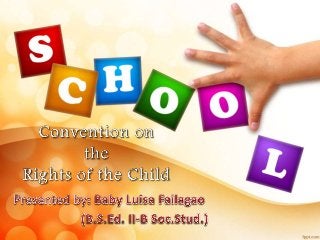Convention on the Rights of The Child
•Download as PPTX, PDF•
3 likes•2,510 views
prof.ed topic
Report
Share
Report
Share

Recommended
The UN CRC in child-friendly language, English, published by UNICEF South AfricaUN Convention on the Rights of the Child - child-friendly version (English)

UN Convention on the Rights of the Child - child-friendly version (English)UNICEF Europe & Central Asia
Recommended
The UN CRC in child-friendly language, English, published by UNICEF South AfricaUN Convention on the Rights of the Child - child-friendly version (English)

UN Convention on the Rights of the Child - child-friendly version (English)UNICEF Europe & Central Asia
Powerpoint PresentationUgnayang Bayan 2015 - Convention on the Rights of Child (CRC)

Ugnayang Bayan 2015 - Convention on the Rights of Child (CRC)Presidential Human Rights Committee - Secretariat
More Related Content
Viewers also liked
Powerpoint PresentationUgnayang Bayan 2015 - Convention on the Rights of Child (CRC)

Ugnayang Bayan 2015 - Convention on the Rights of Child (CRC)Presidential Human Rights Committee - Secretariat
Viewers also liked (17)
The Policy and Practice of Preparing the Nigerian Teacher for the Challenges ...

The Policy and Practice of Preparing the Nigerian Teacher for the Challenges ...
The State of the World’s Children in Numbers: Every Child Counts – Revealing ...

The State of the World’s Children in Numbers: Every Child Counts – Revealing ...
Ugnayang Bayan 2015 - Convention on the Rights of Child (CRC)

Ugnayang Bayan 2015 - Convention on the Rights of Child (CRC)
Implementation Handbook for the Convention on the Rights of the Child

Implementation Handbook for the Convention on the Rights of the Child
Recently uploaded
Recently uploaded (20)
Mixin Classes in Odoo 17 How to Extend Models Using Mixin Classes

Mixin Classes in Odoo 17 How to Extend Models Using Mixin Classes
Python Notes for mca i year students osmania university.docx

Python Notes for mca i year students osmania university.docx
Unit-IV; Professional Sales Representative (PSR).pptx

Unit-IV; Professional Sales Representative (PSR).pptx
ICT role in 21st century education and it's challenges.

ICT role in 21st century education and it's challenges.
Kodo Millet PPT made by Ghanshyam bairwa college of Agriculture kumher bhara...

Kodo Millet PPT made by Ghanshyam bairwa college of Agriculture kumher bhara...
Basic Civil Engineering first year Notes- Chapter 4 Building.pptx

Basic Civil Engineering first year Notes- Chapter 4 Building.pptx
UGC NET Paper 1 Mathematical Reasoning & Aptitude.pdf

UGC NET Paper 1 Mathematical Reasoning & Aptitude.pdf
Convention on the Rights of The Child
- 2. The 54 Articles of the CRC describe 4 categories of Rights: 1. Survival rights- covers a child’s right to life and the needs that are most basic to existence. 2. Development rights- include what children require to reach their fullest potential. 3. Protection rights- recognizes the vulnerability of children by preserving their identity & nationality. 4. Participation rights- allow children to take an active role in their communities and nations.
- 3. Rights & Responsibilities While we expect our rights to be respected, protected & promoted, we should also be willing to undertake the corresponding responsibilities. We cannot think only of the promotion of our own rights without thinking of the rights of others. When we exercise our rights we need to take care that we do not violate or deny other people’s rights.
- 4. Peace Theme 2: Challenging Prejudice & Building Tolerance • Gordon Allport (1958) asserts that humans have a propensity toward justice. Prejudice is the negative feeling or attitude towards a person or a group even if it lacks basis Stereotype refers to the negative opinion about a person or group based on incomplete knowledge Discrimination refers to negative actions toward members of a specific social group that may be manifested in avoidance , aversion or even violence
- 5. Types of Prejudice • Racism- the belief that one’s own cultural or racial heritage is innately superior to that of others • Sexism- a system of attitudes, actions & structures that subordinates others on the basis of their sex • Heterosexism-negative attitudes toward lesbian and gay men • Classism-distancing from perceiving the poor as “the other”
- 6. • Linguicism-negative attitudes which members of dominant language groups hold against non-dominant language groups • Ageism-negative attitudes held against the young or the elderly • Looksism-prejudice against those who do not measure up to set standards of beauty. • Religious intolerance-prejudice against those who are the followers of religious other than one’s own
- 7. Education for Tolerance & Respect • One effective way to challenge prejudice is by teaching tolerance • Tolerance is not tolerating what is unjust but it is respecting , accepting and appreciating the rich diversity of cultures and various forms of human expression ( UNESCO, 1995) • Education for tolerance aims to counter influences that lead to fear , discrimination and exclusion of others • Tolerance recognizes that others have the right to be who they are
- 8. Peace Theme 3: Promoting Nonviolence Nonviolence is the refusal to do harm to other humans as life is sacred & is an absoute value. It is anchored on the belief that humans have the potential to change Mohandas Gandhi, the man who led the people of India out of british subjugation held the following beliefs about nonviolence:
- 9. Why Nonviolence? It is both an ethical and moral choice In Jainism, it is taught that a wise person “does not kill, nor consent to the killings by others” Lao Tzu , founder of Taoism taught that “weapons are instruments of evil and not of a good ruler” In Buddhism, the precept “not to kill “ is the foundation for all Buddhist action. Everyone is believed to have been born with a Buddha nature so “ no one has the right to take the life of another”.
